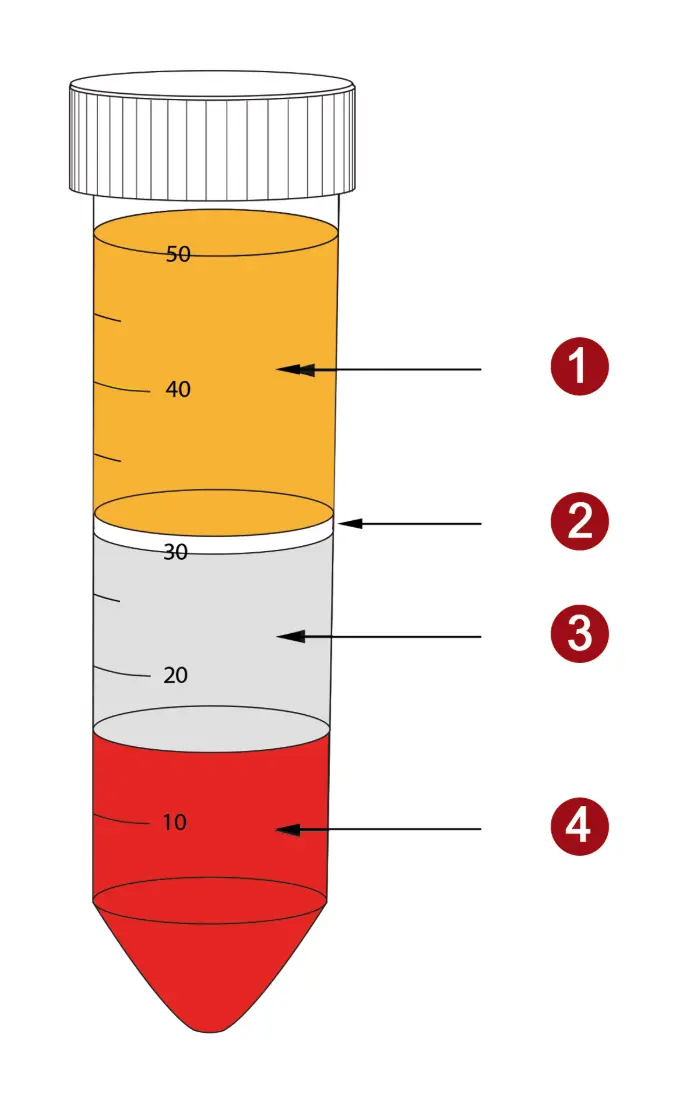PBMC - Peripheral Blood Mononuclear Cell
A peripheral blood mononuclear cell (PBMC) is a blood cell with a single, round nucleus. The term "peripheral" refers to mature blood cells that are not located in haematopoietic organs such as the bone marrow, but circulate in the peripheral blood.
NOTE: Peripheral blood is the blood that enters the blood vessels after its formation in the bone marrow and circulates there. In our article: "Whole blood as starting material for cell separation." contains further interesting information on the subject of blood.
The main components of peripheral blood include blood plasma, which serves as a transport medium, red Blood cells (erythrocytes), White blood cells (leucocytes) and blood platelets (thrombocytes).
PBMCs, sometimes referred to as PMNCs (peripheral mononuclear cells) or MNCs (mononuclear cells), comprise all mononuclear leukocytes. These include:
- Lymphocytes (T-cells, B-cells, NK-cells)
- Monocytes
- dendritic cells and
- basophilic granulocytes.
Enrichment of PBMC by density gradient centrifugation
The term PBMC (peripheral blood mononuclear cells) is closely associated with the accumulation of cells from Whole blood by means of a density gradient centrifugation. Separation of the blood components is possible as they have different densities; this is done by one-step centrifugation in a suitable density gradient medium. The cut-off for the mononuclear cells is 1.077 g/ml.
The density gradient-enriched PBMC are sometimes referred to as buffy coat. In this context, buffy coat describes the layer of enriched leukocytes in the interphase. For this particular case, PBMC, the buffy coat consists only of mononuclear cells and is in this sense a special buffy coat.
Polymorphonuclear leukocytes (with multiple segmented nuclei), such as granulocytes, are depleted in PBMC. Neutrophil and eosinophil granulocytes can therefore not be enriched from a PBMC fraction prepared by standard density gradient separation (the medium has a density of 1.077 g/ml). Basophilic granulocytes differ in density and can be partially found in the PBMC fraction. Erythrocytes are strongly reduced compared to the initial cell count.
General process of PBMC enrichment using a density gradient medium
First, a synthetic polymer solution with a defined density is overlaid with blood or sample material. After preparation, a centrifugation step is carried out. The cells accumulate in the interphase between the two solutions at the corresponding density. The interphase containing the PBMCs is carefully removed. The enriched mononuclear cells are then washed and used for further application.
Isolation or enrichment of PBMC with PBMC Spin Medium
The Whole blood (1) is first carefully applied to the PBMC Spin Medium (2), which is placed in a centrifuge tube. Care must be taken to ensure that the two liquids do not mix. Alternatively, pluriMate tubes can be used. The pluriMate barrier facilitates layering and prevents the sample material from mixing with the density gradient medium.

Fig. 1: PBMC preparation with PBMC Spin Medium. The sample material (1) is carefully placed on the density medium (2).
In the following centrifugation step, the actual density gradient centrifugationthe sample is separated into the different layers. The mononuclear cells (2) are enriched between the plasma (1) and the density medium (3).
